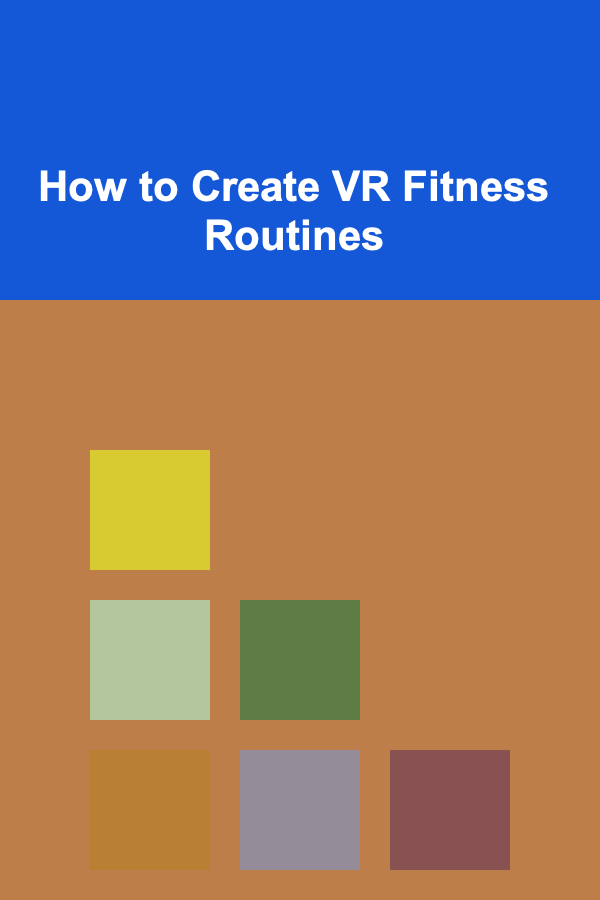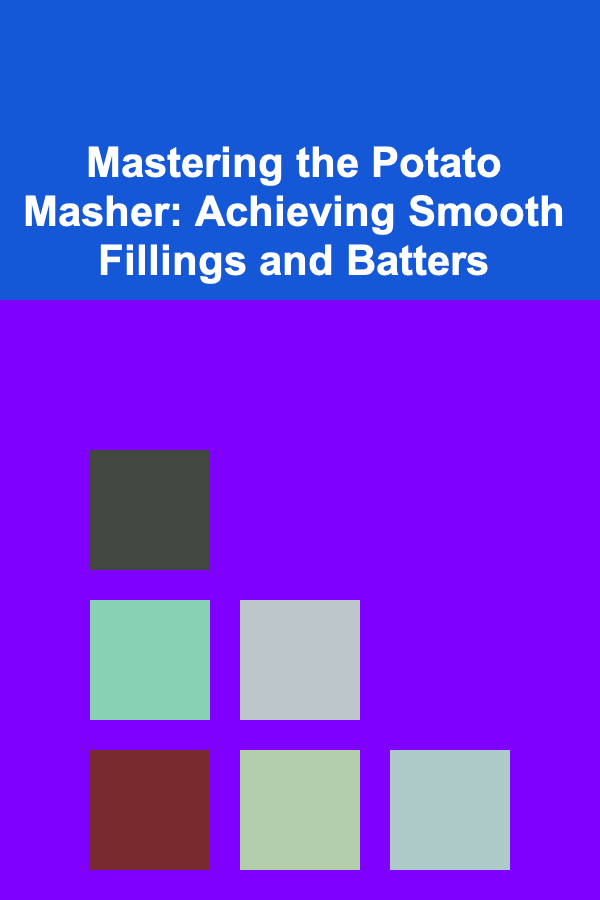
How to Create VR Fitness Routines
ebook include PDF & Audio bundle (Micro Guide)
$12.99$5.99
Limited Time Offer! Order within the next:

In recent years, Virtual Reality (VR) has made a significant impact across various industries, from gaming to healthcare, and now, fitness. As technology continues to evolve, VR has the potential to revolutionize the way we approach fitness, offering immersive and engaging workout experiences that go beyond traditional methods. VR fitness routines can provide a wide range of benefits, from making exercise more enjoyable to offering detailed insights into performance and progress.
Creating VR fitness routines isn't just about putting a VR headset on and moving your body. It's about crafting experiences that are not only effective but also safe, motivating, and accessible to a wide audience. In this article, we will explore how to create VR fitness routines, the technology involved, key considerations, and the future of fitness in a virtual world.
Understanding VR in Fitness
Virtual Reality is a computer-generated environment that allows users to interact with a three-dimensional world in real-time. By using VR headsets and motion controllers, users can engage in various virtual experiences that feel real. In the context of fitness, VR can offer virtual environments where users perform exercises, follow routines, and experience workouts in ways that traditional fitness setups cannot provide.
The integration of VR into fitness routines offers several advantages:
- Engagement: VR workouts are immersive and dynamic, providing a level of engagement that makes exercising more enjoyable.
- Motivation: Virtual environments, such as competing in a race or completing a mission, can increase motivation and push users to complete their routines.
- Variety: VR offers a wide variety of fitness experiences, from virtual cycling and running to yoga, strength training, and high-intensity interval training (HIIT).
- Tracking and Feedback: Many VR fitness systems integrate tracking and data collection, allowing users to monitor their progress and set goals.
- Accessibility: VR can make fitness routines accessible to those who may not have access to a gym or personal trainer, as well as people with disabilities who may find traditional fitness methods challenging.
While the potential of VR fitness is immense, creating an effective and engaging VR fitness routine requires careful consideration of several factors, including the type of exercise, the technology involved, and the user experience.
Key Components of VR Fitness Routines
Creating VR fitness routines that work requires a solid understanding of fitness principles as well as the specific needs of VR technology. Here are the key components involved in creating a successful VR fitness routine:
1. Choosing the Right Exercise Type
The first step in creating a VR fitness routine is to determine the type of exercise or workout you want to focus on. Different types of exercise target different aspects of fitness, such as strength, cardiovascular health, flexibility, or balance. VR fitness can accommodate a wide range of exercise types, including:
- Cardiovascular Workouts: These exercises aim to increase heart rate and improve cardiovascular health. VR cycling, running, and rowing are common options for cardiovascular training in virtual environments. Users can experience running through virtual cities, cycling in exotic locations, or rowing on serene lakes.
- Strength Training: Strength-based exercises, such as weightlifting, bodyweight exercises, or resistance training, can also be performed in a VR environment. Although VR doesn't necessarily replace physical weights, virtual resistance training can be incorporated, and VR fitness systems can track the user's movements and provide virtual weights or resistance bands to enhance the workout.
- Yoga and Pilates: VR is especially effective for low-impact workouts such as yoga and Pilates. Virtual instructors can guide users through poses, and the immersive environment can add an extra layer of relaxation and focus.
- HIIT and Circuit Training: High-intensity interval training (HIIT) and circuit training are popular for users looking for quick, intense workouts. In VR, these workouts can include activities like jumping, squatting, punching, or even virtual obstacle courses, all of which keep the user engaged while delivering effective results.
- Balance and Coordination: VR is great for exercises that focus on balance and coordination, such as tai chi or stability ball exercises. The technology allows users to practice different movements while maintaining a high level of precision.
2. Virtual Environment Design
The design of the virtual environment plays a critical role in the success of the VR fitness routine. The environment should be immersive, motivating, and conducive to the type of exercise being performed. Here are some design considerations:
- Immersion: The virtual world should feel lifelike, with realistic visuals, sound effects, and interactions. This enhances the overall experience and helps users focus on their workout. For example, a VR cycling experience might include realistic weather effects, distant mountains, and road sounds, making users feel as though they are riding through a real-world landscape.
- Customization: Giving users the ability to customize their environment adds a layer of personalization. For example, users could choose different settings for their workouts, such as cycling through a tropical beach or hiking through a forest. Personalization not only increases enjoyment but can also help users find an environment that motivates them to keep going.
- Interactivity: VR fitness routines can benefit from interactive elements that challenge users or provide goals. These can range from scoring systems, achievements, and leaderboards to challenges where users have to complete specific tasks or missions, such as reaching a destination or completing a certain number of repetitions.
- Aesthetic Appeal: The aesthetic design should be visually appealing without being overly distracting. The goal is to make the virtual world inviting and motivating, while still focusing on the workout.
3. User Movement and Tracking
In VR fitness routines, user movement and tracking are essential for ensuring that the exercises are being performed correctly and that the system can provide feedback to improve performance. There are several important factors related to movement tracking:
- Motion Tracking: VR systems use sensors or external cameras to track a user's movements in real-time. For fitness routines, this involves tracking body movements such as arm swings, leg lifts, or squats. Accurate tracking ensures that the user's movements align with the virtual environment, providing an effective workout.
- Real-Time Feedback: One of the benefits of VR fitness is the ability to provide instant feedback on form and performance. For example, if a user is performing a squat incorrectly, the system can provide corrections to improve posture and reduce the risk of injury. Similarly, users can receive encouragement when they reach specific goals, like completing a certain number of repetitions or achieving a target heart rate.
- Progress Tracking: VR fitness systems can track user performance over time, allowing users to see their progress in terms of calories burned, distance traveled, or improvements in strength. This data can be used to set future fitness goals, creating a sense of accomplishment and motivating users to continue.
- Adaptive Difficulty: Some VR fitness routines adjust the difficulty of the workout based on the user's fitness level. For example, the intensity of a running workout may increase gradually as the user's endurance improves. Adaptive difficulty ensures that users remain challenged while still progressing at their own pace.
4. Safety and Comfort
Safety is a key consideration when designing VR fitness routines. VR workouts require users to move in ways that may be unfamiliar, and there are potential risks of injury if users are not careful. Here are some safety tips to keep in mind:
- Space Requirements: Users should have enough space to perform their exercises without hitting walls, furniture, or other objects. This can be achieved by creating clear guidelines in the VR environment that show the user their safe workout area.
- Safety Guidelines: Instruct users on proper form and technique to avoid injury. Virtual trainers can guide users through exercises with voice cues, visual demonstrations, and reminders to maintain good posture.
- Breaks and Recovery: VR fitness can be intense, especially in high-impact or cardio-based routines. Including breaks for rest and hydration is important to prevent fatigue and injuries. Users should also be reminded to warm up before starting and cool down afterward.
- Comfortable Gear: Since VR requires wearing a headset and using controllers or other accessories, it's important to ensure that the gear is comfortable for extended use. Adjustments to the VR headset (e.g., size, padding) and controllers can make the experience more comfortable and prevent discomfort during workouts.
5. User Motivation and Engagement
Motivation plays a crucial role in the success of VR fitness routines. Since VR is an immersive experience, it has the potential to motivate users more effectively than traditional fitness routines. Here are some strategies for boosting user motivation:
- Gamification: By adding elements of gamification, such as scoring, achievements, and levels, users can feel a sense of accomplishment. Completing missions, earning points, and unlocking new environments or challenges keeps the experience fresh and exciting.
- Social Interaction: Many people find motivation in exercising with others. VR fitness can incorporate multiplayer features, allowing users to work out together in virtual spaces or compete against one another in challenges.
- Personalized Goals: Tailoring fitness routines to individual users and allowing them to set personal goals can increase motivation. Whether it's running a specific distance or reaching a set number of repetitions, personalized goals keep users focused and committed.
- Real-World Integration: VR fitness can also integrate real-world activities. For example, users could track their real-world steps or calories burned and then sync them with their virtual progress, creating a sense of continuity between the virtual and physical worlds.
The Future of VR Fitness
The future of VR fitness is bright, with the potential to redefine how we approach exercise and wellness. As VR technology continues to improve, we can expect even more sophisticated and immersive workout experiences. The integration of artificial intelligence (AI), machine learning, and real-time biometric tracking will further enhance personalization, safety, and performance.
Additionally, advancements in VR hardware, such as lighter headsets, more accurate motion sensors, and wireless capabilities, will improve accessibility and comfort, making VR fitness routines even more appealing to a wider audience.
In the long run, VR could complement traditional fitness regimes by offering alternative workout experiences, particularly for those who may find conventional gym routines monotonous or inaccessible. VR fitness has the potential to provide users with an engaging and effective way to stay fit, whether at home or in specialized VR fitness centers.
Conclusion
Creating VR fitness routines involves a careful blend of technology, fitness principles, and user experience design. By considering the right exercise types, designing engaging virtual environments, ensuring accurate movement tracking, and prioritizing safety and comfort, developers can craft immersive and effective fitness experiences. As VR technology continues to evolve, the potential for innovative and dynamic fitness routines will only grow, transforming the way we approach health and fitness in the digital age.

How to Adjust Portion Sizes for Individual Meal Prep
Read More
How to Create a Cozy Holiday Atmosphere with Simple Decorations
Read More
How to Plan a Fun Family Game Night for All Ages
Read More
How to Plan a Weight Loss Strategy for Men
Read More
How to Control Your Data in Health and Fitness Apps
Read More
Mastering the Potato Masher: Achieving Smooth Fillings and Batters
Read MoreOther Products

How to Adjust Portion Sizes for Individual Meal Prep
Read More
How to Create a Cozy Holiday Atmosphere with Simple Decorations
Read More
How to Plan a Fun Family Game Night for All Ages
Read More
How to Plan a Weight Loss Strategy for Men
Read More
How to Control Your Data in Health and Fitness Apps
Read More